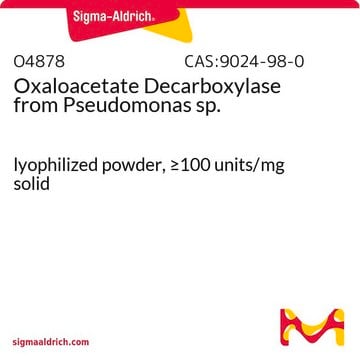The sensitivity is 2 µM (2 µmol/L).
MAK070
Oxaloacetate Assay Kit
sufficient for 100 colorimetric or fluorometric tests
About This Item
Recommended Products
usage
sufficient for 100 colorimetric or fluorometric tests
detection method
colorimetric
fluorometric
relevant disease(s)
cancer
storage temp.
−20°C
General description
Application
Suitability
Principle
replaced by
Signal Word
Danger
Hazard Statements
Precautionary Statements
Hazard Classifications
Eye Irrit. 2 - Resp. Sens. 1 - Skin Sens. 1
Storage Class Code
10 - Combustible liquids
Choose from one of the most recent versions:
Certificates of Analysis (COA)
Don't see the Right Version?
If you require a particular version, you can look up a specific certificate by the Lot or Batch number.
Already Own This Product?
Find documentation for the products that you have recently purchased in the Document Library.
Articles
Sigma article discusses tumor cell metabolic pathways, focusing on aerobic glycolysis and mitochondrial activity.
Fatty acid synthesis supports cancer cell proliferation, essential for membrane generation, protein modification, and bioenergetics.
-
How sensitive is your oxaloacetate kit? Please do not just inidcate nmoles.Specify molar amounts per unit volume. For example nmoes/ml or umoles/liter. Thanks.
1 answer-
Helpful?
-
-
Can this kit be used with samples like bacteria, plants, drosophila, yeast etc?
1 answer-
We have optimized the kit with mammalian samples. However, theoretically these kits should work with samples from multiple species/sources. OAA is conserved through evolution. Since the optimal conditions depend on the sample type, the protocol has to be be adapted to fit the samples for efficient results. Please refer to this kit's citations to see what kind of samples have been used with this kit other than mammalian samples.
Helpful?
-
-
Why is deproteinizing necessary for this assay?
1 answer-
We suggest deproteinizing samples using a PCA/KOH protocol (BioVision, Cat. #K808-200) or passing the samples through 10 kDa molecular weight cut off spin columns (BioVision, Cat # 1997-25). This will get rid of much of the protein in the samples and can remove the enzymes which can be converting OAA to pyruvate already.
Helpful?
-
-
Are trial sizes of this kit available?
1 answer-
Unfortunately, we do not have trial sizes of this kit available. However,for customers based in the US or Canada, a 10% off list price introductory discount can be offered on the list price. For all other customers based out of this area our regional BioVision distributor should be contacted.
Helpful?
-
-
Is it possible to use a different wavelength than recommended for the final analysis?
1 answer-
It is always recommended to use the exact recommended wavelength for the most efficient results. However, most plate readers have flexibility in their band width of detection in increments of +/- 10 nm. Depending on this flexibility range, you can deviate from the recommended wavelengths within limits.
Helpful?
-
-
What is the exact volume of sample required for this assay?
1 answer-
There is no specific volume we can recommend for the amount any sample to be used since it is completely sample concentration and quality based. It is recommended to do a pilot expt with multiple sample volumes to determine the optimal volume which gives a reading within the linear range of the standard curve. Please refer to the citations for this product to see what other clients have used with similar sample types.
Helpful?
-
-
Can individual components of this kit be purchased separately?
1 answer-
Yes, any of the kit's components can be purchased separately without having to buy the whole kit. Please refer to the component Cat #s mentioned on the datasheet for ordering.
Helpful?
-
-
Can frozen samples be used with this assay?
1 answer-
Fresh samples are always preferred over frozen samples. However, frozen samples can also be used, provided, they were frozen right after isolation, were not freeze thawed multiple time (for which we recommend aliquoting the samples before freezing) and have been frozen for relatively short periods.
Helpful?
-
Active Filters
Our team of scientists has experience in all areas of research including Life Science, Material Science, Chemical Synthesis, Chromatography, Analytical and many others.
Contact Technical Service






